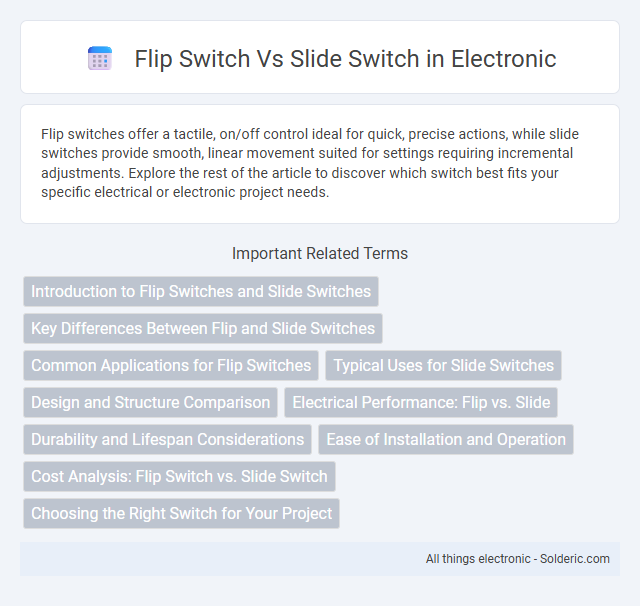Flip switches offer a tactile, on/off control ideal for quick, precise actions, while slide switches provide smooth, linear movement suited for settings requiring incremental adjustments. Explore the rest of the article to discover which switch best fits your specific electrical or electronic project needs.
Comparison Table
| Feature | Flip Switch | Slide Switch |
|---|---|---|
| Operation | Flipping lever up or down | Sliding button left or right |
| Size | Bulkier, larger lever | Compact, low profile |
| Typical Use | Power control, visibility required | Compact electronics, space-saving |
| Durability | Robust, withstands rough use | Moderate, less mechanical stress |
| Installation | Panel mount common | PCB mount common |
| Switch Action | Momentary or maintained | Maintained only |
| Cost | Generally higher | Generally lower |
Introduction to Flip Switches and Slide Switches
Flip switches and slide switches are two common types of mechanical switches used to control electrical circuits by opening or closing contacts. Flip switches feature a lever that pivots back and forth, offering a clear tactile indication of on/off positions, making them ideal for power controls and quick operation. Slide switches operate by sliding a knob along a track, providing precise control in compact electronic devices like audio equipment and handheld gadgets.
Key Differences Between Flip and Slide Switches
Flip switches feature a lever that moves up or down to open or close a circuit, offering tactile feedback and a clear on/off position, while slide switches operate by sliding a knob horizontally to change states. Flip switches often provide more robust mechanical action suitable for industrial applications, whereas slide switches are compact and commonly used in electronics requiring space efficiency. The choice between flip and slide switches depends on factors such as size constraints, user interface preference, and environmental durability.
Common Applications for Flip Switches
Flip switches are commonly used in household appliances, automotive controls, and industrial machinery due to their durable design and clear on/off positions. Their tactile feedback makes them ideal for power tools, lighting fixtures, and audio equipment where precise control is essential. You will find flip switches favored in environments requiring reliable manual operation under various conditions.
Typical Uses for Slide Switches
Slide switches are commonly used in smaller electronic devices such as flashlights, audio equipment, and handheld gadgets due to their compact size and ease of operation. They excel in applications requiring a simple on/off function or mode selection without the need for complex control. Their low profile design makes them ideal for PCB mounting in consumer electronics and wearable technology.
Design and Structure Comparison
Flip switches feature a lever or toggle that moves between on and off positions, offering a tactile, audible click for clear feedback, while slide switches use a sliding mechanism that glides along a track, providing smooth, precise control. Flip switches often have a more compact and robust design, ideal for rugged applications, whereas slide switches typically have a low-profile structure suitable for slim devices and tight spaces. Your choice depends on the required user interaction and device form factor, with flip switches favoring durability and slide switches excelling in sleek, space-saving designs.
Electrical Performance: Flip vs. Slide
Flip switches typically offer reliable electrical performance with a clear on/off state, ensuring stable current flow in circuits requiring distinct control positions. Slide switches provide smooth operation and precise control over electrical connections, often preferred in applications needing incremental adjustments or multi-position settings. Your choice between flip and slide switches should consider voltage ratings, current capacity, and mechanical durability to match the specific electrical performance requirements of your project.
Durability and Lifespan Considerations
Flip switches typically offer higher durability and longer lifespan due to their robust mechanical design, making them ideal for applications requiring frequent use and reliable performance. Slide switches, while compact and suitable for low-profile designs, may experience faster wear and reduced longevity under heavy or repetitive operation. Your choice should consider the operational environment and expected switch cycles to ensure optimal durability.
Ease of Installation and Operation
Flip switches offer straightforward installation with simple snap-in or screw mounting options, making them ideal for quick setups. Slide switches require precise alignment during installation but provide smooth, tactile operation that can prevent accidental activation. Choosing the right switch depends on your preference for ease of installation versus the desired operational feel.
Cost Analysis: Flip Switch vs. Slide Switch
Flip switches generally offer a lower cost compared to slide switches due to simpler manufacturing processes and fewer components. Slide switches provide more precise control and durability, which can justify a higher price point in applications requiring reliability and fine-tuned operation. Your choice between flip and slide switches should consider both initial cost and long-term performance demands.
Choosing the Right Switch for Your Project
Choosing the right switch for your project depends on factors like space constraints, user interface preferences, and electrical requirements. Flip switches offer a tactile, secure on/off control ideal for robust applications, while slide switches provide a compact design suitable for low-profile devices and fine adjustments. Evaluating the switch's voltage rating, current capacity, and actuation style ensures optimal functionality and durability in your specific use case.
flip switch vs slide switch Infographic

 solderic.com
solderic.com